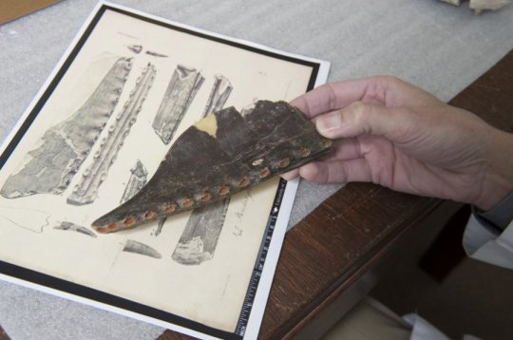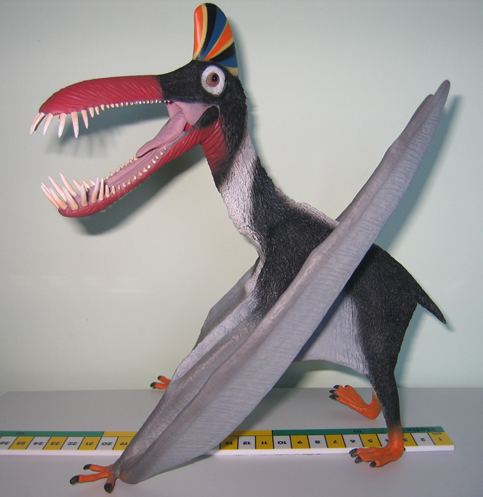Texas Pterosaurs and Their Close English Cousin
North America’s Newest Pterosaur – Cimoliopterus dunni
A new species of fish-eating, toothy flying reptile has been named and described from a partial rostrum found by an amateur fossil hunter in Texas. This new Texas pterosaur named Cimliopterus dunni is the second in the Cimliopterus genus, the first, now named Cimliopterus cuvieri is known from fossil material found close to Maidstone in Kent (southern England). This newly described Texan pterosaur links Texas to England according to the author of the scientific paper just published in the academic journal the “Journal of Vertebrate Paleontology”, Dr Timothy S. Myers.
The Fossilised Rostrum (beak) of the New Texan Pterosaur
Picture credit: Hillsman Jackson, Southern Methodist University
In the picture above, the Texas fossil specimen, found in 2013 is compared against the illustrations made of the 1851 Maidstone fossil find.
Small Fossil = Big Problems
Both the English 1851 pterosaur fossil (found in a chalk pit near Maidstone, Kent) and the Texas material belong to the family of pterosaurs called the Ornithocheiridae, a diverse and globally distributed pterosaur family. They have both been assigned to the genus Cimoliopterus, however, the English fossil material was known by several other names before finally being assigned a genus of its own back in 2013, coincidently the same year as the Texas rostrum was found, as prolific amateur fossil collector Brent Dunn was exploring the spillway of Lake Lewisville, north of Dallas.
Many of the pterosaur fossils found in southern England and assigned to the Ornithocheiridae are extremely fragmentary. During the latter half of the 19th century some of the leading scientists of the time, Owen, Seeley and Hooley studied the very worn and poorly preserved pterosaur fossils excavated from the upper Cretaceous chalk deposits of southern England. Between name they named a number of genera, most of which were based on mere scraps of fossils with very few if any clearly defined autapomorphies (distinctive anatomical features).
Assigned to the Pterodactylus Genus
When first described, the Maidstone specimen was assigned to the Pterodactylus genus, over the years this assessment fell out of favour and various other names were erected. Richard Owen for example, re-named this specimen as Coloborhynchus cuvieri. Further revisions followed, just two years ago the specimen was assigned its own genus and named Cimliopterus cuvieri (Rodrigues and Kellner). The genus name means “chalk wing”, the species name in this case honours the French scientist and anatomist Georges Cuvier. The Texas trivial name honours the fossil finder – Brent Dunn who sadly passed away a few months after his discovery.
As both the English and American fossils were found in marine sediments, biostratigraphical dating has been carried out. These fossils date from the Cretaceous, from around 94 million years ago, a time when the Atlantic was beginning to open up and North America was splitting away from Europe as the super continent of Laursaia broke up.
Pterosaur Relatives from Two Diverging Landmasses
Closely related flying reptile species one from the southern United States and one from southern England suggests that these reptiles moved between North America and England earlier in the Cretaceous, despite the gradual widening of the nascent Atlantic Ocean, a process that is on-going today. They are different species so some evolutionary divergence must have occurred, in essence two groups of the same species became separated and gradually over time they took slightly different evolutionary paths resulting in two distinct species being found in the fossil record.
Commenting on his research, Dr Myers (Research Curator, Shuler Museum of Palaeontology, Southern Methodist University) stated:
“The Atlantic opened the super-continent Pangaea like a zipper, separating continents and leaving animal populations isolated, so gene flow ceased and we start to see evolutionary divergence. Animals start to look different and you see different species on one continent versus another. Pterosaurs are a little trickier because unlike land animals they can fly and disperse across bodies of water. The later ones are pretty good flyers.”
A Typical Member of the Ornithocheiridae (Guidraco from China)
Picture credit: Everything Dinosaur
The picture above shows a typical member of the Ornithocheiridae pterosaur family. As a group they are noted for their dentition (teeth), the long and pointed fangs of these creatures were particularly well suited to catching fish. Most of the fossils of ornithocheirids are associated with marine deposits, so it has been suggested that these pterosaurs were accomplished fliers able to soar effortlessly over the sea rather like some species of sea bird do today.
The CollectA Deluxe model range contains a number of scale models of iconic pterosaurs: CollectA Deluxe Prehistoric Life Models.
The Lack of Toothy Pterosaur Fossils from North America
The fossil record to date shows that toothed pterosaurs are generally abundant during the Cretaceous in Europe, Asia and South America, but the fossils of this type of flying reptile are exceedingly rare in North America.
The new Texas native, Cimoliopterus dunni, is only the third toothed pterosaur species from the Cretaceous of North America. All three of the toothy Cretaceous-era pterosaurs discovered so far from North America were found in the “Lone Star” State. Even so, Cimoliopterus dunni is most closely related to England’s Cimoliopterus cuvieri and not to the other two genus of Texan toothy pterosaur so far named (Aetodactylus halli, also named by Dr Myers (2010) and Uktenadactylus wadleighi* which was named in 1994).
Texan Pterosaurs
Despite all three Texan toothed pterosaurs being assigned to the Ornithocheiridae family, the two other pterosaurs are associated with older strata. In the case of Uktenadactylus*, these fossil remains are associated with rocks at least ten million years older than the marine shale deposits where the rostrum of Cimoliopterus dunni was found.
To read Everything Dinosaur’s article on the discovery of Aetodactylus: The Expanding Ornithocheiridae, say hello to “Eagle Finger” of Texas.
Ironically, Uktenadactylus also has a very close relative known from England – Coloborhynchus clavirostris known from the Albian age Cambridge Greensand deposits which underlie many of the chalk formations to be found in England.
Dr Myers explained:
“Given the small sample size, it’s odd that we have two that are so closely related to the English species. It’s hard to draw any statistically significant conclusions from that, but it definitely indicates this is not a one-off, and that there was some relatively strong, significant connection. Two means a lot more than one in this case.”
Dr Myers is not hypothesising about a land bridge connecting these two continents, although sea levels may have fluctuated over time resulting in these types of pterosaur indulging in a bit of “island hopping” only for the sea levels to rise again, isolating groups of these flying reptiles which led to the speciation.
The Bizarre Global Distribution of the Toothed Pterosaurs
Despite the identification of a third species of toothy Pterosaur from Texas, the mystery of why there is so little evidence to tie in North American and South American Pterosauria remains.
Dr Myers added:
“There are toothed Pteranodontoids in South America, lots of individuals and lots of different species, but no close relatives to the toothed Pteranodontoids in North America. That might indicate there was some barrier to dispersal from the south. It’s unusual we don’t see a connection between these pterosaur populations. Maybe we will when we find more of this material.”
The quest to find more toothed pterosaur specimens can catch even the most dedicated and experienced palaeontologist out. Back in January 2011, Everything Dinosaur reported on the naming of a new genus of toothed pterosaur identified from a partial jaw discovered in Canada. The pterosaur was named Gwawinapterus beardi. However, subsequent analysis revealed that the fossil specimen was more likely to have come from a prehistoric predatory fish.
To read about the Canadian discovery: New Pterosaur with Teeth Like a Piranha.
Gwawinapterus Unravelled: Mistake in Naming Flying Reptile.
*Formerly known as Coloborhynchus wadleighi.



